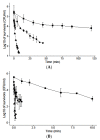Nanoemulsified D-Limonene Reduces the Heat Resistance of Salmonella Senftenberg over 50 Times
- PMID: 28336899
- PMCID: PMC5388167
- DOI: 10.3390/nano7030065
Nanoemulsified D-Limonene Reduces the Heat Resistance of Salmonella Senftenberg over 50 Times
Abstract
Salmonella Senftenberg is a pathogen agent causative of foodborne disease and it is considered the most heat-resistant serovar within this genus. Food industries use heat treatment and chemical antimicrobials in order to eliminate this microorganism in food, but consumers prefer natural antimicrobials as essential oils and their components. This study evaluates the combined effect of thermal treatments and different concentrations of D-limonene nanoemulsion on the inactivation of Salmonella (S.) Senftenberg. The results showed an important effect of the nanoemulsified D-limonene on the heat resistance of S. Senftenberg. The δ50 °C value was reduced by 85%, 96% and 98% when 0.1, 0.5 and 1 mM of nanoemulsified D-limonene was added to the heating medium. The effect was kept along all the heating temperatures researched and the shape of the survival curves did not change with the addition of the antimicrobial. The results obtained in this research could be very useful for food industries for optimizing or improving heat treatments applied to food.
Keywords: D-limonene; Salmonella Senftenberg; antimicrobial; combined effect; food; heat resistance; nanoemulsions; nanomaterials; safety.
Conflict of interest statement
The authors declare no conflict of interest. The founding sponsors had no role in the design of the study; in the collection, analyses, or interpretation of data; in the writing of the manuscript, and in the decision to publish the results.
Figures
Similar articles
-
Limonene nanoemulsified with soya lecithin reduces the intensity of non-isothermal treatments for inactivation of Listeria monocytogenes.Sci Rep. 2020 Feb 27;10(1):3656. doi: 10.1038/s41598-020-60571-9. Sci Rep. 2020. PMID: 32107438 Free PMC article.
-
Fat and fibre interfere with the dramatic effect that nanoemulsified d-limonene has on the heat resistance of Listeria monocytogenes.Food Microbiol. 2017 Apr;62:270-274. doi: 10.1016/j.fm.2016.10.031. Epub 2016 Oct 21. Food Microbiol. 2017. PMID: 27889158
-
A comparative study of thermal and acid inactivation kinetics in fruit juices of Salmonella enterica serovar Typhimurium and Salmonella enterica serovar Senftenberg grown at acidic conditions.Foodborne Pathog Dis. 2009 Nov;6(9):1147-55. doi: 10.1089/fpd.2009.0313. Foodborne Pathog Dis. 2009. PMID: 19694554
-
Combination of pulsed electric fields, mild heat and essential oils as an alternative to the ultrapasteurization of liquid whole egg.Int J Food Microbiol. 2014 Oct 17;189:119-25. doi: 10.1016/j.ijfoodmicro.2014.08.002. Epub 2014 Aug 9. Int J Food Microbiol. 2014. PMID: 25146463
-
Relationship between membrane fatty acid composition and heat resistance of acid and cold stressed Salmonella senftenberg CECT 4384.Food Microbiol. 2009 May;26(3):347-53. doi: 10.1016/j.fm.2008.11.002. Epub 2008 Dec 3. Food Microbiol. 2009. PMID: 19269580
Cited by
-
Relevance of the Induced Stress Resistance When Identifying the Critical Microorganism for Microbial Risk Assessment.Front Microbiol. 2018 Jul 24;9:1663. doi: 10.3389/fmicb.2018.01663. eCollection 2018. Front Microbiol. 2018. PMID: 30087669 Free PMC article.
-
Training in tools to develop quantitative microbial risk assessment of ready-to-eat food with a comparison between the Romanian and Spanish food supply chains.EFSA J. 2023 Nov 30;21(Suppl 1):e211006. doi: 10.2903/j.efsa.2023.e211006. eCollection 2023 Nov. EFSA J. 2023. PMID: 38047124 Free PMC article.
-
On the use of in-silico simulations to support experimental design: A case study in microbial inactivation of foods.PLoS One. 2019 Aug 27;14(8):e0220683. doi: 10.1371/journal.pone.0220683. eCollection 2019. PLoS One. 2019. PMID: 31454353 Free PMC article.
-
Limonene nanoemulsified with soya lecithin reduces the intensity of non-isothermal treatments for inactivation of Listeria monocytogenes.Sci Rep. 2020 Feb 27;10(1):3656. doi: 10.1038/s41598-020-60571-9. Sci Rep. 2020. PMID: 32107438 Free PMC article.
-
Phytochemical Characterization, Antioxidant, and Antimicrobial Activity of the Vegetative Buds from Romanian Spruce, Picea abies (L.) H. Karst.Molecules. 2024 May 3;29(9):2128. doi: 10.3390/molecules29092128. Molecules. 2024. PMID: 38731619 Free PMC article.
References
-
- Kumar A., Kumar S. Survival kinetics of Salmonella enterica serotype senftenberg (S. senftenberg) after heat and acid stress. World J. Microbiol. Biotechnol. 2003;19:985–987. doi: 10.1023/B:WIBI.0000007417.14213.79. - DOI
-
- Mañas P., Pagán R., Álvarez I., Condón S. Survival of Salmonella Senftenberg 775 W to current whole egg pasteurization treatments. Food Microbiol. 2003;20:593–600. doi: 10.1016/S0740-0020(02)00088-6. - DOI
LinkOut - more resources
Full Text Sources
Other Literature Sources


